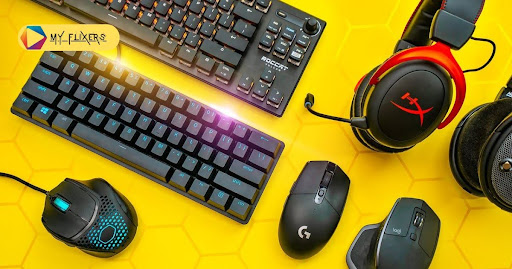In the fast-paced world of competitive gaming, technology is the driving force behind innovation and growth. The USA has emerged as a powerhouse in the true sports arena, with tech advancements revolutionizing how we play, watch, and experience digital athletics. This comprehensive guide delves into the cutting-edge trends shaping the future of tech transports in competitive gaming.
Read Also: Tech eTrueSports: Leading Tournament Organizers Revolutionizing the Gaming Industry
Overview of Major Technological Advancements in eSports
The landscape of competitive gaming has undergone a dramatic transformation since its inception. Let’s explore the key milestones that have propelled transports into the spotlight:
Early days of eSports and Initial Technological Setups
In the nascent stages of competitive gaming, players gathered in local arcades or LAN parties, using basic hardware and limited networking capabilities. These early setups were far from the sophisticated systems we see today:
- CRT monitors with low refresh rates
- Basic keyboards and mice
- Dial-up internet connections
- Limited voice communication options
Despite these constraints, passionate gamers laid the foundation for a global phenomenon. The transition to online play marked a significant leap forward, enabling players to compete across vast distances and fostering a sense of international community.
Development of Online Multiplayer Platforms
The advent of robust online platforms revolutionized transport. Services like Steam, Battle.net, and Xbox Live created ecosystems where players could easily find opponents, track statistics, and participate in organized tournaments. These platforms brought several key innovations:
- Matchmaking algorithms
- Integrated voice and text chat
- Digital distribution of games
- Achievement systems
- Friend lists and social features
As these platforms evolved, they became more than just gaming hubs – they transformed into social networks for gamers, fostering communities and driving the growth of transport.
Advances in Gaming Hardware and Peripherals

As transports gained traction, hardware manufacturers began developing specialized equipment to meet the demands of competitive players. High-refresh-rate monitors, mechanical keyboards, and precision mice became staples in the pro-gaming arsenal. Let’s break down some of the key advancements:
Hardware Type Early eSports Modern eSports
Monitors 60Hz CRT 360Hz+ IPS/TN panels
Keyboards Membrane Optical/mechanical switches
Mice Ball mice 16,000+ DPI optical sensors
Headsets Basic stereo 7.1 surround sound, noise-cancelling
These technological leaps have not only improved player performance but also enhanced the overall gaming experience for both competitors and spectators.
Tech Etruesports Impact on the E-Sports Industry
The influence of technology on transport cannot be overstated. Let’s break down the key areas where tech is making waves:
Read Also: What is Qxefv? A Complete Guide to This Enigmatic Phenomenon
Hardware Advancements
- High-performance PCs: Custom-built rigs with top-tier GPUs and CPUs ensure smooth gameplay and minimal latency. These machines often feature:
- Overclocked processors
- Liquid cooling systems
- Multiple GPUs in SLI/CrossFire configurations
- High-speed SSDs for rapid game loading
- Gaming monitors: 240Hz+ refresh rates and 1ms response times provide ultra-smooth visuals. New technologies like OLED and mini-LED are pushing the boundaries of colour accuracy and contrast.
- Specialized peripherals: Pro-grade mice, keyboards, and headsets offer precision and comfort during long gaming sessions. Features include:
- Adjustable weights in mice
- Customizable key switches in keyboards
- Advanced audio drivers in headsets
Software Solutions
- AI-powered training tools: Machine learning algorithms analyze player performance and provide personalized coaching. These tools can:
- Identify patterns in gameplay
- Suggest optimal strategies
- Predict opponent moves
- Analytics platforms: Advanced statistics help teams and players identify strengths and weaknesses. These platforms often include:
- Heat maps of player movement
- Weapon usage statistics
- Team composition analysis
- Anti-cheat systems: Sophisticated software ensures fair play in competitive environments by:
- Monitoring system processes
- Analyzing player behaviour for anomalies
- Implementing hardware-level detection
Streaming and Broadcasting
The rise of platforms like Twitch and YouTube Gaming has transformed how audiences engage with transports. 4K and even 8K streaming capabilities bring the action to life, while AR overlays enhance the viewer experience with real-time stats and analysis. Key innovations include:
- Low-latency streaming protocols
- Interactive viewer experiences (e.g., Twitch extensions)
- AI-powered highlight generation
- Multi-language broadcasting
Virtual Reality (VR) and Augmented Reality (AR)
VR and AR technologies are opening up new frontiers in competitive gaming:
- Immersive spectator experiences: Viewers can feel inside the game, watching the action unfold around them.
- VR training simulations: Pro players can practice in virtual environments that mimic real tournament conditions.
- AR-enhanced live events: Spectators at physical venues can use AR devices to see additional information and statistics overlaid on the real world.
“VR and AR are not just enhancing the viewer experience; they’re creating entirely new ways to play and compete.” – John Carmack, VR pioneer
Data Analytics and AI
Big data is revolutionizing strategy and player development in transports:
Application Description Example
Performance tracking AI algorithms analyze gameplay data to identify trends and areas for improvement IBM Watson’s analysis of Overwatch League data
Predictive modelling Teams use data-driven insights to develop winning strategies AI-generated team compositions in MOBAs
Audience engagement Analytics help organizers tailor events to viewer preferences Personalized content recommendations on streaming platforms
Future Trends and Predictions
As we look to the horizon, several exciting developments are poised to shape the future of tech transport:
Tech Etruesports Trends in Competitive Gaming
- Brain-computer interfaces: Direct neural connections could revolutionize player input and control. Imagine controlling your in-game character with just your thoughts!
- Haptic feedback suits: Full-body immersion for players and potentially spectators. These suits could let you feel the impact of in-game actions, adding a new dimension to the gaming experience.
- AI-generated content: Dynamic, ever-evolving game scenarios created by artificial intelligence. This could lead to:
- Infinitely replayable games
- Personalized challenges for each player
- AI opponents that adapt in real-time
- Cross-platform competitions: Universal ranking systems across multiple games and platforms, allowing for true multi-game champions.
Predictions for Future Growth and Technological Integration

Experts forecast continued exponential growth in the e-sports industry, with global revenues expected to surpass $5 billion by 2025. Technological integration will likely focus on:
- Enhanced cybersecurity measures: As the stakes in transports continue to rise, protecting players and tournament integrity will become increasingly crucial. We may see:
- Blockchain-based verification systems
- Biometric authentication for players
- AI-powered anomaly detection in gameplay
- Improved accessibility features: Making competitive gaming more inclusive is not just ethically important; it’s also good for business. Future developments might include:
- Adaptive controllers for players with physical disabilities
- Real-time translation services for international competitions
- Customizable UI elements for players with visual impairments
- Advanced biometric monitoring: Player health and performance optimization will become increasingly sophisticated. Potential applications include:
- Real-time stress level monitoring
- Optimized training regimens based on physiological data
- Early detection of gaming-related health issues
The Evolution of a Pro Gamer’s Setup
To illustrate the rapid advancement of tech in transports, let’s compare the setup of a professional Counter-Strike player in 2010 vs. 2024:
Component 2010 Setup 2024 Setup
Monitor 60Hz CRT 360Hz 4K OLED
Mouse 800 DPI optical 25,000 DPI with adjustable weight
Keyboard Standard membrane Optical switches with per-key RGB
PC Dual-core CPU, 4GB RAM 32-core CPU, 128GB RAM, dual GPUs
Headset Stereo, wired Wireless, noise-cancelling, 3D audio
Chair Basic office chair Ergonomic gaming chair with biofeedback
This dramatic evolution in equipment has not only improved player performance but also raised the bar for what’s possible in competitive gaming.
FAQs
What is Tech Etruesports?
Tech Etruesports refers to the technological advancements and innovations driving the competitive gaming industry, encompassing hardware, software, and infrastructure developments that enhance player performance, viewer experience, and overall ecosystem growth.
How does Tech Etruesports contribute to the eSports industry?
Tech Etruesports drives innovation in competitive gaming by:
- Improving gameplay quality and fairness
- Enhancing spectator experiences
- Facilitating global competitions
- Providing data-driven insights for players and teams
What types of gaming peripherals does Tech Etruesports offer?
Tech Etruesports encompasses a wide range of specialized gaming peripherals, including:
- High-precision optical and laser mice
- Mechanical keyboards with customizable switches
- Low-latency wireless headsets
- Ergonomic gaming chairs and desks
How does Tech Etruesports use AI in eSports?
AI is utilized in Tech Etruesports for:
- Player performance analysis and coaching
- Game balance and design optimization
- Cheat detection and prevention
- Personalized content recommendations for viewers
What future trends can we expect from Tech Etruesports?
Emerging trends in Tech Etruesports include:
- Integration of blockchain technology for secure transactions and digital asset ownership
- Advanced haptic feedback systems for increased immersion
- AI-driven dynamic difficulty adjustment in competitive games
- Expanded use of VR and AR in both gameplay and spectatorship
Conclusion
The world of tech and esports is evolving at a breakneck pace, pushing the boundaries of what’s possible in competitive gaming. From cutting-edge hardware to AI-driven analytics, these technological advancements are not only enhancing the player and spectator experience but also opening up new avenues for career opportunities and global connectivity.
As we look to the future, it’s clear that the fusion of sports and technology will continue to drive innovation in unexpected and exciting ways. The lines between physical and digital sports are blurring, with true sports paving the way for new forms of competition and entertainment.

